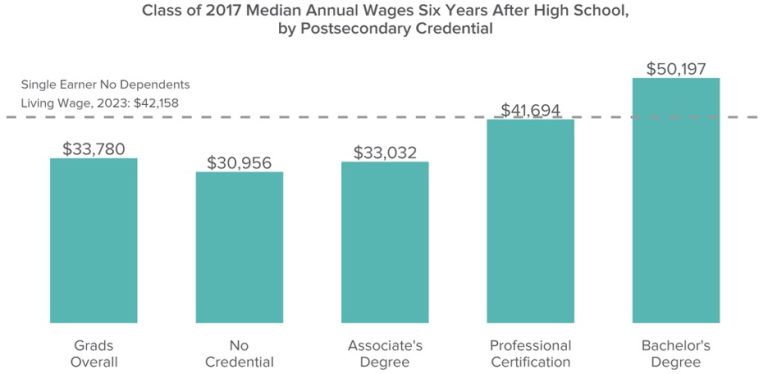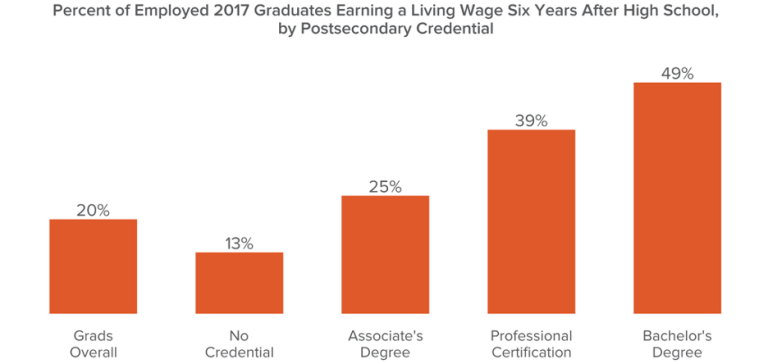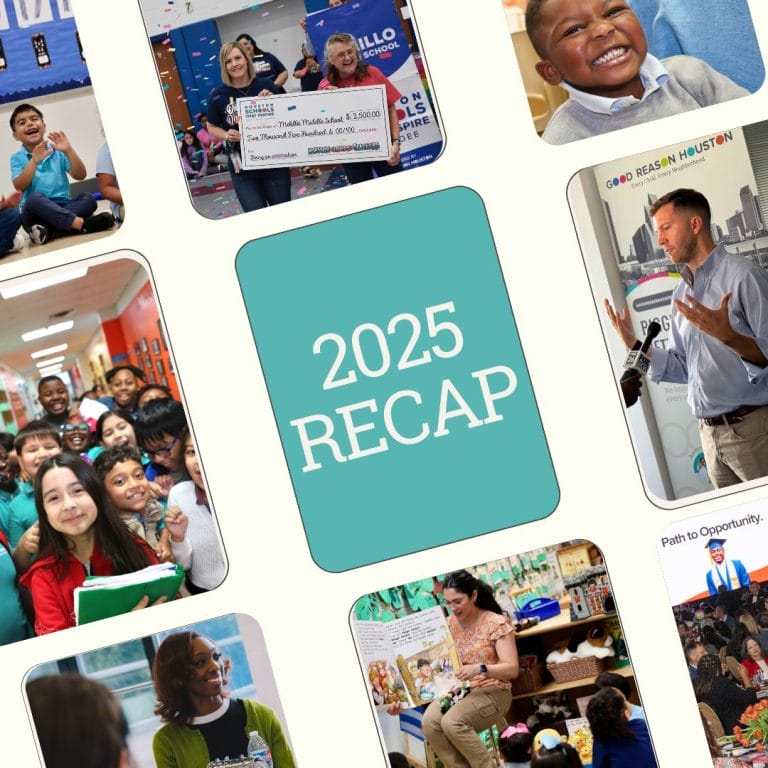Over the past year, Good Reason Houston’s Research and Data team has been digging into how our region’s high school graduates are faring after graduation. Earlier this year, we shared early findings on postsecondary credential attainment, and now, in this month’s ConnectEd, we’re excited to share new insights on another key factor of long-term success: living wage attainment.
Massachusetts Institute of Technology defines a living wage as the minimum income a full-time worker needs to cover basic costs — things like housing, food, transportation, and child care — without relying on outside help. MIT estimated that in Harris County in 2023 a single person with no dependents would need to earn $42,158 before taxes to meet these basic needs.
We believe that our education system should prepare graduates for more than just a diploma; it should set them up for success and opportunity. That means helping them earn enough to meet their basic needs—and thrive. This is why living wage attainment, at minimum, is a focus of our ongoing research into postsecondary outcomes.
To dive into the full findings, check out our latest report. And as always, if you have questions or want to share your thoughts, feel free to reach out to us at info@goodreasonhouston.org, reply to this email, or connect with us on social media using #HTXConnectEd.
Sincerely,
Good Reason Houston’s Research and Data Team
The Gist:
Below are key takeaways from this month’s Houston ConnectEd.
- The median annual wage for 2017 graduates six years after high school (in 2023) was $33,780, well below the living wage threshold of $42,158 for a single-earner household with no dependents.
- Only 20% of 2017 graduates earned enough to qualify as a living wage six years after high school.
- Compared to 2017 graduates with no postsecondary credential, graduates with credentials were more likely to earn a living wage:a. Bachelor’s degree holders: 3.8x more likely;
b. Professional certification holders: 3x more likely;
c. Associate’s degree holders: 2x more likely.
Keep reading for a comprehensive perspective on Houston public education data.
Living Wage Attainment for Houston Graduates
A key measure of how well our education system is working is whether graduates can earn enough to support themselves and their families. Comparing their earnings to a living wage—what it costs to cover basic needs—helps us assess this.
In 2023, the living wage for a single person in Harris County with no dependents was $42,158. Among the high school class of 2017, only those with bachelor’s degrees earned more than that six years later. Those with professional certifications came close, indicating that they may represent an opportunity for our graduates and system. Awarded by two-year colleges, these certifications can often be attained within only a semester or two, so the time and financial commitment required is significantly less than an associate’s or bachelor’s degree. Currently, though, only 3-4% of graduates attain one. Regardless, most graduates, nearly three-quarters, do not have any postsecondary education and only earned median wages of about $31,000. The figures seen below include graduates working full-time jobs but don’t account for gig or contract work.

Postsecondary credentials are essential to living wage attainment. Compared to graduates with no postsecondary credential, graduates with certifications or degrees were much more likely to meet living wage standards:
- Bachelor’s degree holders were 3.8x more likely,
- Professional certification holders were 3x more likely, and
- Associate’s degree holders were 2x more likely to earn a living wage.
Still, the vast majority of graduates did not earn a living wage. Even among bachelor’s degree holders, just under half met living wage standards for a single earner household with no dependents. For earners with dependents, the numbers were even more startling: only 4% of 2017 graduates made enough six years after high school to support themselves and a single dependent.

These numbers highlight two key points. First, our education system needs to do more to help students gain the skills and credentials they need after high school. With more jobs requiring education beyond a high school diploma, it’s not sustainable for so many graduates (73%) to lack postsecondary credentials.
Second, ensuring graduates can earn enough to support themselves isn’t just about what happens in schools—it’s also about employers. Companies should reconsider the wages they offer, even to skilled workers. If we want our region to thrive and attract top talent, we all need to work together—schools, employers, and the community—to better prepare and value our workforce.
Data in the News
Here are some of the education data stories we’ve been keeping our eye on over the past few weeks.
- New TEA dashboard shows that demand for teacher certification programs far exceeded spots in these programs: As the percentage of new teachers hired without teaching certifications continues to grow in Texas, it is critically important that these teachers have access to quality pathways to certification. Recent research shows that students taught by uncertified teachers do not achieve the same outcomes as those taught by certified teachers. Unfortunately, new data from the Texas Education Agency shows less than half of applicants to teacher certification programs last year were admitted. We need to better understand the barriers to enrolling in certification programs
- Quality prekindergarten programs are especially beneficial for emergent bilingual students, who make up one-third of Houston-region students: This article discusses the importance of access to high-quality early learning opportunities, particularly for students whose first language is something other than English. As the demographic composition of our public school system continues to evolve, we should ensure that all students, regardless of background, have access to high-quality pre-K that can set them up for long-term academic success. Good Reason Houston has found that emergent bilingual (EB) students in the Houston region who were eligible for and attended free public pre-K were more than twice as likely to be considered kindergarten ready than their EB peers who were eligible and did not attend public pre-K.





